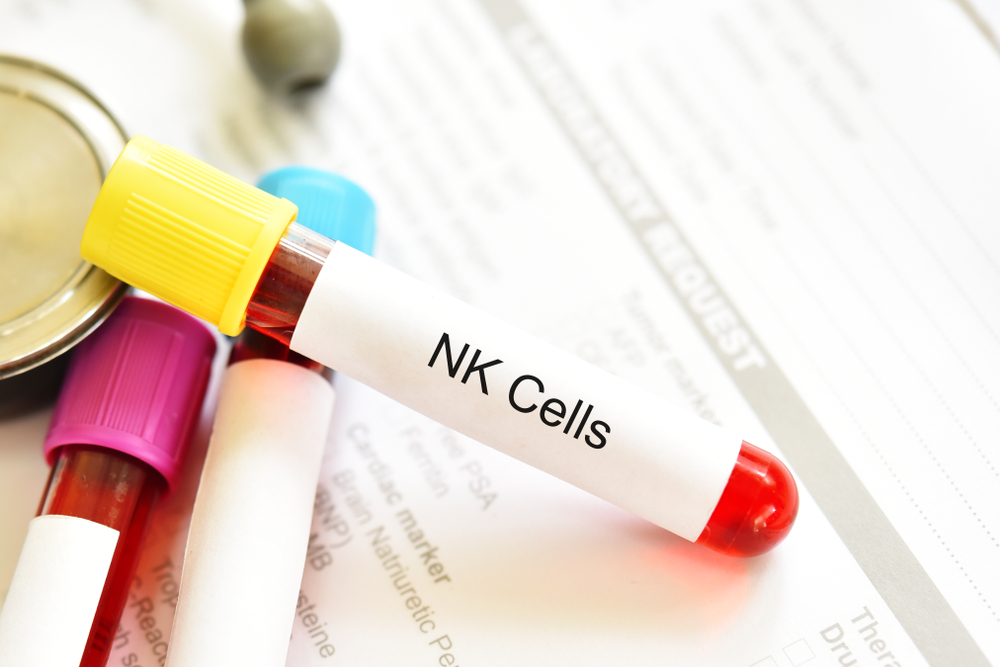 #News
#News
Using the immune system to fight brain cancer
Research reveals that immune cells modified with CAR and cytokine have the potential to cure up to 67% of mice with glioblastoma, paving the way for new treatments
 CAR-modified natural killer (NK) cells showed the highest success rate at curing mice with glioblastoma when compared to other immune cells (T lymphocytes and macrophages) | Image: Shutterstock
CAR-modified natural killer (NK) cells showed the highest success rate at curing mice with glioblastoma when compared to other immune cells (T lymphocytes and macrophages) | Image: Shutterstock
Researchers from the University of Zurich, Switzerland, were able to cure 40–67% of mice with glioblastoma, one of the most aggressive forms of brain cancer.
To do so, they inserted the CAR (chimeric antigen receptor) gene, which recognizes the tumors and triggers an immune response, into three types of immune system cells from the animals’ blood: T lymphocytes, macrophages, and NK (natural killer) cells.
The study was published in the journal Cell on February 18.
In addition to CAR, which recognizes the tumor and activates the immune system, the researchers also introduced a second gene responsible for the production of cytokine, a substance that stimulates inflammation and boosts the impact of immune cells. The modified cells were then reinserted into the bloodstream of the mice.
Of the three cell types tested, NK cells were the most effective, curing 4 out of 6 mice after 40 days (67%). Macrophages had a 50% success rate, while T lymphocytes cured 40%.
The approach is similar to CAR-T cell therapy, which has already been approved for the treatment of blood cancers, such as lymphoma, certain types of leukemia, and multiple myeloma. However, CAR-T cells face limitations when it comes to the treatment of solid tumors.
“Without the cytokine, the CAR-modified immune cells had little effect on the tumor: they slightly increased the survival time of the mice but did not cure them,” the study authors wrote.
Development of new therapies
The scientists suggest that CAR-NK and CAR-macrophage therapies are promising alternatives to engineered T lymphocytes because they have a lower risk of causing excessive inflammation, one of the challenges of CAR-T cell therapy (learn more about CAR-NK cell therapies).
Erica Heipertz, a molecular biologist from American biotechnology company Thermo Fisher Scientific who was not involved in the study, also believes in the potential of CAR-NK therapy.
She points out that this type of cell is extremely safe and has not caused serious side effects in human trials, even when derived from donors—something that cannot be said for CAR-T cell therapy.
“NK cells could be another option for treating blood cancers, and perhaps even solid tumors,” Heipertz told the company’s website.
Differentiator
Another difference in the new study was the use of mice with an intact immune system. Typically, this type of research is conducted on animals with suppressed immune systems, which can limit the understanding of interactions between the immune system and the tumor.
In addition to testing the effectiveness of different cell types, the researchers detailed their mechanisms of action, which could aid in the development of new therapies. The modified T lymphocytes infiltrated the tumors the most, but they did not accumulate on them as much as the NK cells and macrophages.
The results reinforce the need to explore different genetic engineering strategies to tackle solid tumors. “Understanding the advantages and limitations of different immune cells is crucial to developing the next generations of cellular immunotherapies,” the scientists conclude.
-
How does CAR-cell therapy work?
-
Immune system cells are genetically modified to recognize and attack tumors, boosting the immune response.
-
What is the difference between CAR-T, CAR-NK and CAR-macrophage?
-
• CAR-T cells: effective against blood cancers, but with a risk of excessive inflammation.
•CAR-NK cells: safer and more promising for solid tumors.
• CAR-macrophages: can have a greater impact in the tumor microenvironment.
-
Why is cytokine important in cancer treatment?
-
It stimulates inflammation, helping CAR-cells fight the tumor more effectively.
-
Why did the study use mice with intact immune systems?
-
It allowed the team to better understand how the tumor and the immune system interact, aiding in the development of new therapies.
*
This article may be republished online under the CC-BY-NC-ND Creative Commons license.
The text must not be edited and the author(s) and source (Science Arena) must be credited.


